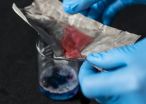(Press-News.org) COLUMBUS, Ohio--The unassuming piece of stainless steel mesh in a lab at The Ohio State University doesn't look like a very big deal, but it could make a big difference for future environmental cleanups.
Water passes through the mesh but oil doesn't, thanks to a nearly invisible oil-repelling coating on its surface.
In tests, researchers mixed water with oil and poured the mixture onto the mesh. The water filtered through the mesh to land in a beaker below. The oil collected on top of the mesh, and rolled off easily into a separate beaker when the mesh was tilted.
The mesh coating is among a suite of nature-inspired nanotechnologies under development at Ohio State and described in two papers in the journal Nature Scientific Reports. Potential applications range from cleaning oil spills to tracking oil deposits underground.
"If you scale this up, you could potentially catch an oil spill with a net," said Bharat Bhushan, Ohio Eminent Scholar and Howard D. Winbigler Professor of mechanical engineering at Ohio State.
The work was partly inspired by lotus leaves, whose bumpy surfaces naturally repel water but not oil. To create a coating that did the opposite, Bhushan and postdoctoral researcher Philip Brown chose to cover a bumpy surface with a polymer embedded with molecules of surfactant--the stuff that gives cleaning power to soap and detergent.
They sprayed a fine dusting of silica nanoparticles onto the stainless steel mesh to create a randomly bumpy surface and layered the polymer and surfactant on top.
The silica, surfactant, polymer, and stainless steel are all non-toxic and relatively inexpensive, said Brown. He estimated that a larger mesh net could be created for less than a dollar per square foot.
Because the coating is only a few hundred nanometers (billionths of a meter) thick, it is mostly undetectable. To the touch, the coated mesh doesn't feel any bumpier than uncoated mesh. The coated mesh is a little less shiny, though, because the coating is only 70 percent transparent.
The researchers chose silica in part because it is an ingredient in glass, and they wanted to explore this technology's potential for creating smudge-free glass coatings. At 70 percent transparency, the coating could work for certain automotive glass applications, such as mirrors, but not most windows or smartphone surfaces.
"Our goal is to reach a transparency in the 90-percent range," Bhushan said. "In all our coatings, different combinations of ingredients in the layers yield different properties. The trick is to select the right layers."
He explained that certain combinations of layers yield nanoparticles that bind to oil instead of repelling it. Such particles could be used to detect oil underground or aid removal in the case of oil spills.
The shape of the nanostructures plays a role, as well. In another project, research assistant Dave Maharaj is investigating what happens when a surface is made of nanotubes. Rather than silica, he experiments with molybdenum disulfide nanotubes, which mix well with oil. The nanotubes are approximately a thousand times smaller than a human hair.
Maharaj measured the friction on the surface of the nanotubes, and compressed them to test how they would hold up under pressure.
"There are natural defects in the structure of the nanotubes," he said. "And under high loads, the defects cause the layers of the tubes to peel apart and create a slippery surface, which greatly reduces friction."
Bhushan envisions that the molybdenum compound's compatibility with oil, coupled with its ability to reduce friction, would make it a good additive for liquid lubricants. In addition, for micro- and nanoscale devices, commercial oils may be too sticky to allow for their efficient operation. Here, he suspects that the molybdenum nanotubes alone could be used to reduce friction.
This work began more than 10 years ago, when Bhushan began building and patenting nano-structured coatings that mimic the texture of the lotus leaf. From there, he and his team have worked to amplify the effect and tailor it for different situations.
"We've studied so many natural surfaces, from leaves to butterfly wings and shark skin, to understand how nature solves certain problems," Bhushan said. "Now we want to go beyond what nature does, in order to solve new problems."
"Nature reaches a limit of what it can do," agreed Brown. "To repel synthetic materials like oils, we need to bring in another level of chemistry that nature doesn't have access to."
INFORMATION:
This work was partly funded by the American Chemical Society Petroleum Research Fund, the National Science Foundation, and Dexerials Corporation (formerly a chemical division of Sony Corp.) in Japan.
Contact: Bharat Bhushan, (614) 292-0651; Bhushan.2@osu.edu
Written by Pam Frost Gorder, (614) 292-9475; Gorder.1@osu.edu
http://www.nature.com/srep/2015/150303/srep08701/full/srep08701.html
http://www.nature.com/srep/2015/150223/srep08539/full/srep08539.html END
April 15, 2015 - Most people who attempt suicide make some type of healthcare visit in the weeks or months before the attempt, reports a study in the May issue of Medical Care, published by Wolters Kluwer.
The study also identifies racial/ethnic differences that may help to target suicide prevention efforts in the doctor's office and other health care settings. The lead author was Brian K. Ahmedani, PhD, LMSW, of Henry Ford Health System, Detroit, Mich.
Health Visits May Provide Chances for Suicide Prevention
Using data from the NIMH-funded Mental Health Research ...
Index shows nearly two points increase in EU overall, but Greece and Latvia fall behind
Sweden tops the table, while UK comes fourth with increase in line with EU average
A healthy and active old age is a reality for many Europeans and is a genuine possibility for many more, despite the 2008 economic crash and years of austerity measures, according to a new United Nations Economic Commission for Europe (UNECE) and European Commission (EC) report, produced at the University of Southampton.
However, countries such as Greece and Latvia have declined in active ageing ...
New work by Ludwig-Maximilians-Universitaet (LMU) in Munich researchers demonstrates that macrophages can effectively substitute for so-called dendritic cells as primers of T-cell-dependent immune responses. Indeed, they stimulate a broader-based response.
The immune response, the process by which the adaptive immune system reacts to, and eliminates foreign substances and cells, depends on a complex interplay between several different cell types. So-called dendritic cells, which recognize and internalize invasive pathogens, play a crucial role in this process. Inside ...
NEWPORT, Ore. - A team of scientists from the United States and Russia has documented the longest migration of a mammal ever recorded - a round-trip trek of nearly 14,000 miles by a whale identified as a critically endangered species that raises questions about its status.
The researchers used satellite-monitored tags to track three western North Pacific gray whales from their primary feeding ground off Russia's Sakhalin Island across the Pacific Ocean and down the West Coast of the United States to Baja, Mexico. One of the tagged whales, dubbed Varvara (which is Russian ...
Anti-fungal drug shows promise as potential new cancer treatment
A common anti-fungal treatment has joined the ranks of drugs that may be suitable for use in treating cancer, according to research from the Repurposing Drugs in Oncology (ReDO) project published in ecancermedicalscience.
The ReDO project is an international collaboration of anticancer researchers dedicated to promoting the cause of common medicines which may represent an untapped source of novel therapies for cancer.
In partnership with ecancer, the ReDO project is publishing a series of papers on drugs ...
Twitter users who post information about their personal health online might be considered by some to be "over-sharers," but new research led by the University of Arizona suggests that health-related tweets may have the potential to be helpful for hospitals.
Led by Sudha Ram, a UA professor of management information systems and computer science, and Dr. Yolande Pengetnze, a physician scientist at the Parkland Center for Clinical Innovation in Dallas, the researchers looked specifically at the chronic condition of asthma and how asthma-related tweets, analyzed alongside ...
WASHINGTON (April 15, 2015) -- The George Washington University (GW) Cancer Institute has finalized 45 core competency statements for oncology patient navigators, who have become critical members of the health care team. These competency statements were published in the Journal of Oncology Navigation and Survivorship and were created through literature review, focus group data analysis, expert review, and a national survey of oncology patient navigation stakeholders.
"Patient navigation is a rapidly growing health profession given new accreditation standards from the ...
Mathematical ideas and tools are often used to describe aspects of large macroscopic systems. Examples abound in areas as varied as finance to psychology. In a paper published last month in the SIAM Journal on Applied Mathematics, author Fabio Bagarello proposes mathematical models to analyze political decision-making. Using a dynamical approach which accounts for interactions between political parties and their constituents, the model tries to deduce whether parties should form coalitions under various circumstances.
"Mathematics is important in many aspects of social ...
Depression and type 2 diabetes mellitus were each associated with an increased risk for dementia and that risk was even greater among individuals diagnosed with both depression and diabetes compared with people who had neither condition, according to an article published online by JAMA Psychiatry.
Diabetes and major depression are common in Western populations and as many as 20 percent of people with type 2 diabetes mellitus also have depression.
Dimitry Davydow, M.D., M.P.H., of the University of Washington School of Medicine, Seattle, and coauthors examined the risk ...
Amsterdam, April 15, 2015 - In a recent study published in Optics Communications, scientists from Bar-Ilan University in Israel have presented a new technique that significantly reduces the halo effect that is generated when using multifocal (contact and intra-ocular) lenses and looking at bright point sources in dark conditions.
Presbyopia is a result of natural aging and stems from a gradual thickening and decrease in elasticity of the lens inside the eye. Corrective lenses used to address presbyopia often lead to a halo effect. This is basically a glow or color light ...




